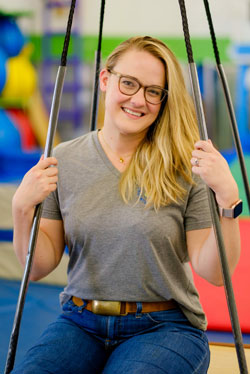What is Orofacial Myofunctional Therapy?
24th May 2022
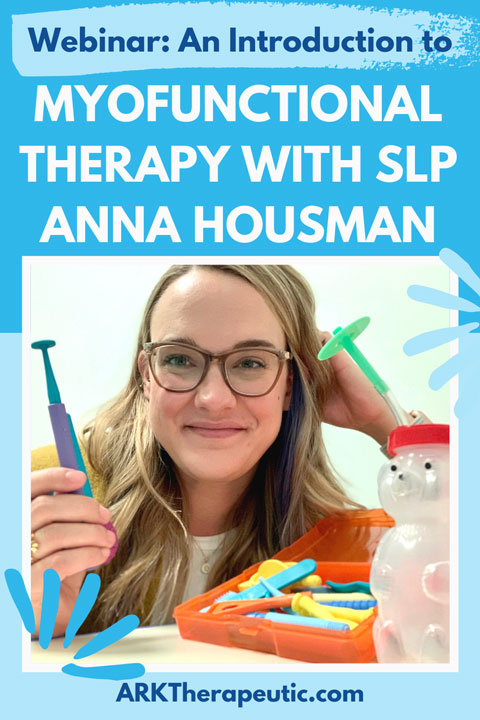
Below is the video and transcript from a live webinar we hosted featuring Speech Language Pathologist and Orofacial Myologist Anna Housman.
In this webinar, Anna will be providing a quick definition of orofacial myofunctional disorders (OMDs), who works in OMDs, and what is targeted in the realm of speech language pathology. She'll also provide insight into her favorite ARK tools for myofunctional therapy, covering tools and tips for working on the jaw, lips, tongue, and feeding.
We hope you find it helpful! If you have any questions at all, please let us know. And feel free to sign up for our newsletter to know about future webinars.
.
Hannah: Alright welcome everyone, and hello! My name is Hannah here at ARK and we are going to be learning about Myofunctional Therapy from Anna Housman. Anna is a speech language therapist and orofacial myologist currently working at Emerge Pediatric Therapy Clinic since 2015 in Durham, NC. Prior to that she worked in the public school system for a year and a half. The bulk of Anna’s career has been spent focused on working in conjunction with occupational therapists (OTs) to understand the sensory systems and how to integrate them into speech therapy.
So we’re really excited to have her here today and I’m just going to go ahead and send it off to Anna to start her presentation!
Anna: Well thank you so much and I’m really blown away by how many people are here - to hear me talk! I appreciate everybody showing up and having questions and being ready to learn more about Orofacial Myofunctional Therapy, along with all the wonderful tools that I’m obsessed with from ARK.
As I was talking with Hannah, we were discussing how Orofacial Myofunctional Therapy - or OMT for short - is kind of an unknown for a lot of people. And to be honest, was not something that I really knew about either. Probably around the time of COVID was when I started diving in and started my certification process. And once I saw it, I couldn’t unsee it! So now it’s become this passion of mine and kind of where my career will continue on and take me from there.
Orofacial myology is just fascinating - it feels like it’s the building blocks for so many things that before, left me with questions of why my clients couldn’t make progress, or why we were stuck in certain places. And as Hannah mentioned, I work really closely with occupational therapists, so seeing how sensory regulation and the whole body getting incorporated into this field is right up my alley.
So let me give you a quick definition of what an OMD, or Orofacial Myofunctional Disorder is - and then we can talk about what the therapy is, who's involved in that therapy, and then I’ll show off some of my favorite tools.
.
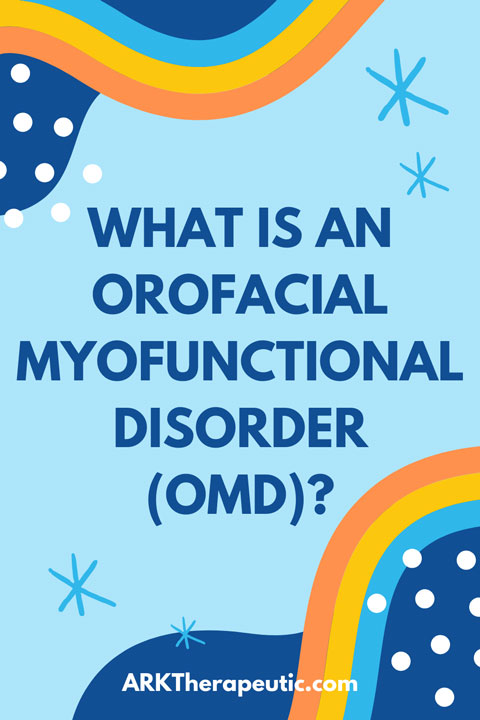
.
What Is an Orofacial Myofunctional Disorder (OMD)? [3:03]:
So an Orofacial Myofunctional Disorder (OMD) is kind of a blanket term - it covers a variety of different disorders, or dysfunctions, in the face. There are things that impact not only the function but also the structure of our face. That includes how our jaw moves, our tongue, teeth, lips, and includes breathing. Usually when I’m describing an Orofacial Myofunctional Disorder in a report, an evaluation - I’ll say, “My client has Orofacial Myofunctional Disorders characterized by:” and then list all of these places because again, it’s a big blanket term.
Orofacial Myofunctional Disorders can impact breastfeeding, how you chew, how you swallow, how you drink, and can have a big impact on your articulation - how your sounds are pronounced. It can impact your occlusion or dentition - how your bite functions. And also overall oral hygiene - do you have cavities, are there incidents of teeth grinding or clenching. Orofacial Myofunctional Disorders can include the TMJ - that temporomandibular joint pain.
The biggest one that’s one of my sub-passion areas is sleep - it’s something that parents are always floored by, but having an OMD can impact how you sleep which can then also impact how your brain functions and learns. It’s just fascinating that that becomes one of my biggest red flags and indicators that a kid might need this type of therapy - is how well, or how poorly, they’re sleeping.
It can also impact general breathing - which if your breathing is not as it should be or not nasal breathing and breathing through your mouth - it opens you up to a whole slew of additional problems ranging from your immune system, how often you get colds, ear infections, and all sorts of things like that.
Orofacial Myofunctional Disorders can also impact how your face looks. It’s kind of a hard line to come across parents in my assessments. I do a lot of facial analysis and I end up having to tell parents their kid’s face is asymmetrical or it’s presenting really long. It’s not that I’m being vain - it’s that our bones and muscles all have different forces that impact each other to create a somewhat “ideal” face shape. And when we see these asymmetries or differences, they kind of point to where we might have an issue. So it’s a very complex set of disorders and people can kind of specialize in small portions of it.
.
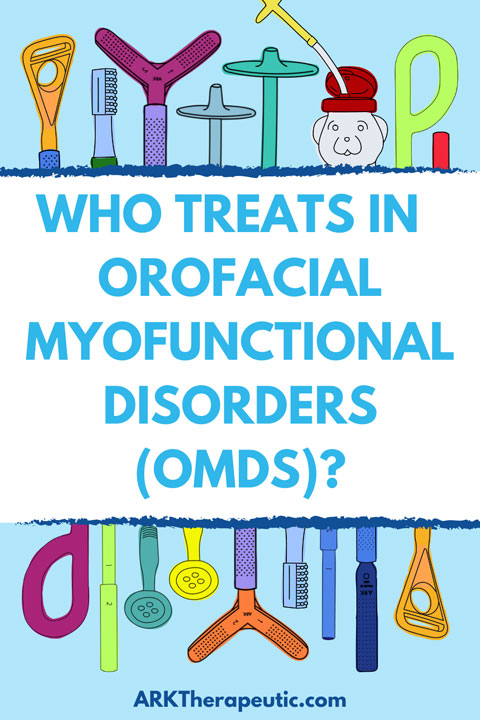
.
Who Treats in Orofacial Myofunctional Disorders? [6:32]:
As far as who often treats in this area of orofacial myology - primarily what I’ve personally seen are speech therapists along with dental hygienists. The dentistry world out there - they’re some of my best friends right now and who I contact and talk to the most!
Additionally on this team and scope of people that fall within the OMD world, we often have lots of "bodyworkers" and that’s another blanket term that I’ll say. That can include physical therapy, occupational therapy, sometimes massage therapists, craniosacral therapists, and I’m sure I’m missing more. But I commonly work with occupational and physical therapists.
There are also ENTs (ear nose and throat doctors), which in my region of the world, are a little bit harder to get on board. Although I’ve seen some of the groups and chats that I belong to, really wonderful involvement and engagement from ENTs. So it all also depends highly on where you live and the medical community around you, as to who can help support you and be a part of this team.
It’s very rare that we find that Orofacial Myofunctional Disorders can just be addressed successfully by one person. I can recognize lots of troubles and make really good referrals, but at the end of the day I’m not an ENT and I’m not an occupational therapist - I can only treat and diagnose within my scope. So what you’ll hear from me is going to vary from what your dental hygienist can do, can vary from ENT is going to do, and is going to be different from what your bodyworker will do.
I’m seeing in the chat that we’ve got some people in the dental field starting to look closely at child development, sleep, and airway. I love hearing that because it’s taking a long time for all of these professions to catch up.
Orofacial Myofunctional Disorders have been kind of a hot topic where we swing wildly in one direction to the other. Your grandparents, my grandparents, great grandparents were probably in an era where everyone got their tongue tie released and everyone got snipped. Then the medical community kind of swung the other way and said, "This isn't necessary, no one’s going to have it done, that’s a myth, there’s no research!"
Now we’re in a place of trying to find balance - that there is a time and a place for this type of therapy, for tongue tie and lip tie releases, but we have to have functional impact. And that was a piece that was missing previously - when it was everyone just gets their tongue tied released. We weren’t considering, “is there a functional deficit?” - because you can have, and we all do - the frenulum under the tongue, the lip, and actually in the cheeks. We all have them, but do you have a functional deficit? And that's where your team comes in to really assess and decide: is this a functional deficit, do we need other interventions, orthodontics, surgery, etc.?
So the more we dive into this we’re finding people across fields really starting to specialize and look at the whole child - not just speech therapists, but dental providers as well looking at airway. We call it “airway centric” - finding those dental hygienists, ENTs and looking at how the airway and muscles functions, and how they impact one another.
I really could talk about that all day! My team is probably very tired of hearing me talk about that here so I’m going to try and moderate how much on my soapbox I get versus talking and showing you some of the products and tools that I use as well.
.

.
As a speech therapist, I like to treat the whole child - and that means I’m not just going to look and take a measurement under the tongue and say yes, here’s a restrictive oral tissue or a tethered oral tissue (TOTs). I’m not just going to look and say "Here it is and let's go have it released, revised, or cut." I start all of my assessments looking at the entire body.
The frenulum under your tongue - this is my favorite fact and blows everybody’s minds if they haven't heard it before - the tissue under your tongue is fascia. It’s like a sticky, stretchy, super thin glue that holds a lot of our muscles and structures in place. It’s very bizarre if you Google it and look at when people pull skin and muscle apart and see this spider-web effect of fascia. That fascia goes from your tongue, down your neck, down your shoulders, through your hips, wraps around your knees, and connects at your heels.
So restrictive oral tissue in your mouth can impact your spine, overall posture, create hip, shoulder, and back pain, change the way you walk, and it can change the comfort and how you sit.
I, myself, had a tongue tie that I recently had released. I went my whole life being fine with no functional deficits until after my first child was born and had this shoulder pain that wouldn’t go away. Uncovered through my profession that I had a tongue tie, had that released and suddenly was able to use all of the exercises from my chiropractor and see improvement because I didn’t have this restrictive tissue impacting my body.
So I start with posture, then the face, and slowly zoom in to a closer picture: I want to see how the jaw functions so I’m often looking at when a child talks: is their jaw moving in unexpected patterns? If I ask them to do something non-speech related: are they able to do something like moving their tongue separate from their jaw? That’s really important for eating and articulation - how does it move, is it set far forward or is it recessed?
All of these things can tell me what kind of structural deficits we may have; it may lead me to thinking more about releasing a tongue tie. But whether or not a tie is there, what I do consider is how can we strengthen and start to help the jaw to move in an appropriate way, decrease any pain that we might be feeling, and also add stability for tongue movements.
.
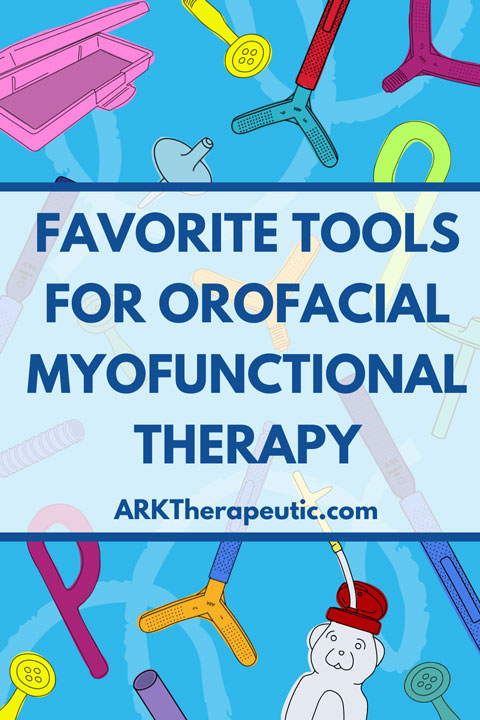
.
Favorite Tools for Orofacial Myofunctional Therapy [14:53]:
So one of my favorite tools are Bite Blocks - I love these from ARK. There's a bunch of different kinds out there in the world but I like these Y shaped ones and then there’s a standalone straight one. I like them both for different reasons - they come graded.
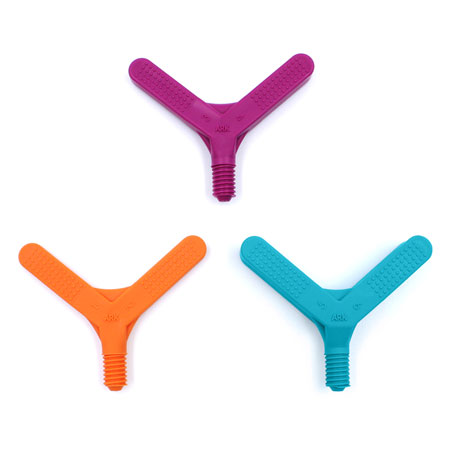
I like to start at the smallest level [orange Y Tip] and working on having my kids bite on the sides and I'm gently pulling. You’d be amazed at how many kids can’t maintain a bite with any kind of pressure, they immediately lose it. And so we’ll start there with building a basic strength so that the next exercise that I layer on top, they have more success with it.
If I ask them to elevate their tongue behind their front teeth, but they have trouble holding their jaw still - their jaw is going all over the place and the tongue is having a hard time, so I like to start with building basic stability and then moving on.
As they get to bigger, and bigger blocks then we can start incorporating exercises like holding the bite block while the tongue elevates. So before when a kid was groping, now they have an extra kind of support to lean on [using the teal Y Tip] while working on that other muscle and their brain can focus at one thing at a time.
One caveat that I’ll probably say a couple times throughout this - these are exercises that I prescribe to my clients based on deficits. So if you’re a parent out there in the world, I would recommend seeking input from a therapist before just starting random exercises that I’m going to present to you.
You want to make sure that you’re targeting the correct muscles and in an order that makes sense to support the goal that you’re seeking. It can be hard to really look at a kid's mouth and say, "their jaw is moving kind of funny" - well why is that? It may be that these [Y Tips] don’t help them and need something different. So these are exercises that I use and love in how I do them but I’m not able to give you the clinical reasoning behind it to help you decide if it’s right for your child.
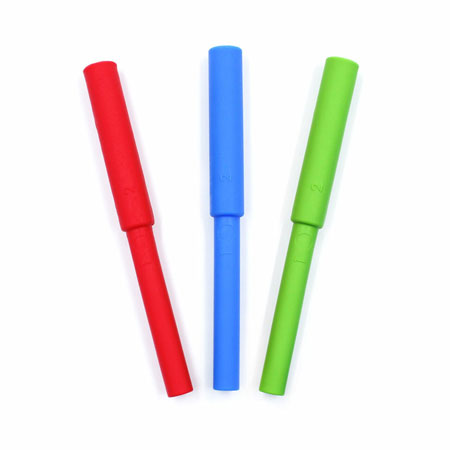
.
Some other exercises that I like to do regarding the jaw - these have quickly become some of my favorites, they're the Hollow Bite Tubes. You can’t see on here but if you were in person you could see that they’re labeled size 1 and 2 on each one and incrementally get more difficult, more firmer. I use these a lot to build up strength and coordination. A lot of times the kiddos that I see have trouble coordinating chewing - and when they are chewing, their tongue isn’t lateralizing.
So I will often take a tube and I start light [using the Bite Tube in red/standard, the softest level] and build up to the blue [in XXT, the toughest level] and hold it to the side [of the mouth] and work with the kid on taking really big bites. Lots of kids who have tethered oral tissues, they munch and take tiny bites in the front because their tongue is not moving food to the back - they’re not used to chewing on the back molars, or food gets stuck back there and food is all over their mouth.
Ideally when you’re chewing and eating, we have our cheek and if the muscles in our cheek are working well and the tongue is working well - they keep the food central on our bite surface. I actually have a giant mouth [demonstrating with mouth doll 19:32] so we have our cheek here and tongue on this side - we’re trying to keep food on this bite surface.
And kids who have Orofacial Myofunctional Disorders often are either pocketing their food because their cheek muscles are weak, or the tongue isn’t lateralizing - it’s not pushing the food onto the surface, just winds up everywhere. So it’s part jaw, tongue, and cheek.
Instead of chewing this way - where the Bite Tube kind of stays directly on my teeth, I like to turn it this way [perpendicular to the molar surface] because it starts to touch and push against my tongue. As I'm chewing, my tongue is naturally trying to work out and figure out why this blue thing [the Bite Tube] is now in my space, so the tongue starts to push back against it and we get to work on a couple things all at once.
I find that too, these [Bite Tubes] - I inadvertently learned they kind of make a sound when the kids bite and make the pieces touch. Some of my kiddos have really found that sound to be funny and motivating to use it!
Additionally I love that they're hollow because I’ll dip them in food. I have kids who are not able to take on a full spoon, but we can explore food and start introducing it into a chewing exercise without having an entire spoonful of applesauce or something to manage. So I love the hollowness for that as oppose to the solid - I have a little more flexibility in what I can do.
Let’s see - so in my assessments again, I’m looking at the jaw and then I might narrow in the lips and how they work. If we have weak lip muscles, we’ll see things like water spilling out when they’re drinking or food collecting at the corners of their mouth. Or we’ll see super tight tension in their face muscles - the mentalis muscles right here on your chin. And often we see bumps arise there [bottom of chin] - where kids really have to over-activate muscles in order to keep food in. I’ve had kids who grind their teeth and that comes from lip instability because they’re over activating all of these muscles and leading them to clench to be able to close.
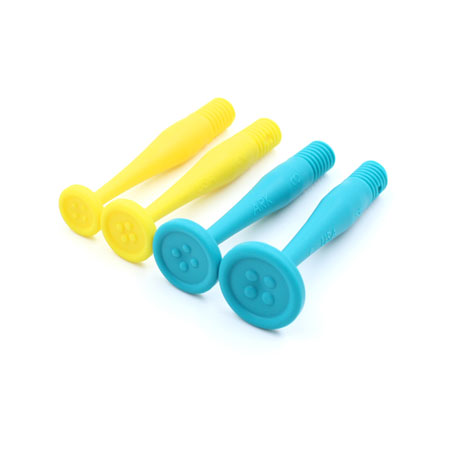
So some of the things that I work on in regards to organizing, coordinating the lip muscles and general lip closure would be our button pulls [using the Button Tips]. When I learned about button pulls, they were demonstrated to me with actual buttons and thread. I don’t love that because I don’t like damp, wet thread - that's what happens to thread when you put it in a kids mouth, and then wash and sanitize it.
For my clinic use, when I saw ARK’s Buttons for the Z-Vibe, I was like, "Sold, I want every size!" Everyone on my team has them because I don’t like damp thread around in our tool kits.
I like the handle - it looks fun and kids love my Z-Vibe! You can turn it on and get vibration, so occasionally for my kids who really have trouble sensing things in their mouth, the vibration is helpful.
I always start with the biggest [the largest teal Button Tip] because it’s the easiest and then you work your way down to the smallest one [the smallest yellow Button Tip].
So we’ll work on the teeth being closed and lips wrapped around [the Button Tip]. And the goal is without suction, we’re sucking in on the button and can they keep the button in their mouth while I give gentle resistance. So building up coordination of all these muscles and working against resistance.
And for some of my kids, that it’s not necessary, again - having a therapist on hand to tell you what your child’s deficit is, is helpful because I have some kids that have so much tension that working on a button pull is going to create even more. But these are great for my kids that have trouble drinking from a straw and things like that.
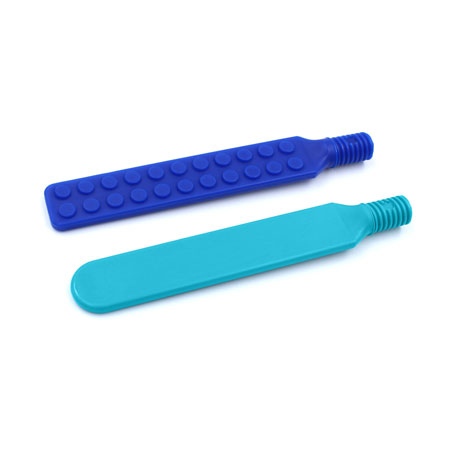
Another one of my favorites, is the Tongue Depressor Tip. I like the one that’s textured but someone has stolen that from my kit so I have my smooth one here.
I'll sometimes use this without the handle but if I have a kid who needs extra sensation to stay alert in a task, I’ll use a tongue depressor and have them hold it against their lips - no teeth involved, to again work on lip closure without facial muscle activation - then I can address nasal breathing.
Additionally I can use it to help train resistance and muscle activation in very specific muscles by pressing [the tongue depressor tip around the mouth] downwards, upwards, in the front, corners - while the lips are closed.
For some of my friends who don’t quite fully grasp what we’re doing, because of cognitive deficits - we'll just work on blowing really big kisses [25:32 putting lips around the Tongue Depressor Tip and make kissing sound] and ask to keep lips closed, and don’t let the kiss go until the tongue depressor is gone. So I’ll use those sometimes and you’ll hear me say to get towards nasal breathing, that’s our ideal rest posture.
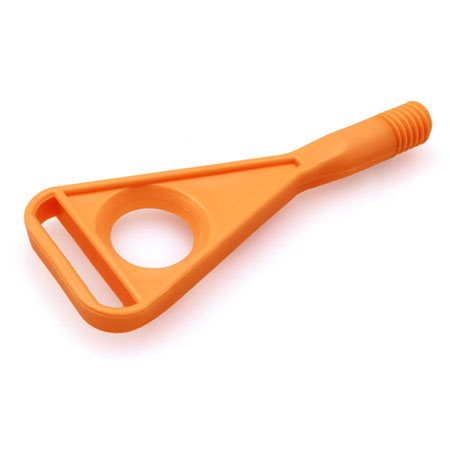
Some other tools that I really like - this is one of my favorites, it’s the Tongue Tip tool. I find that it’s very helpful for my kids who need a visual target. I’ll set them up in front of a mirror and now we’ll work on the tongue.
They’ve reached jaw stability, so I ask, can you keep your jaw open and direct your tongue into this hole [placing the tongue inside hole of Tongue Tip] and follow it [guiding the tongue left to right]?
And can they slide it across this top here [26:30] - it gives a nice tactile input and visual to aim for while we’re working on really skilled fine movements for the tongue.
I would love to do a part two for all of this, but I’m going to be out of maternity leave so it might be a couple of months before we can schedule that again!
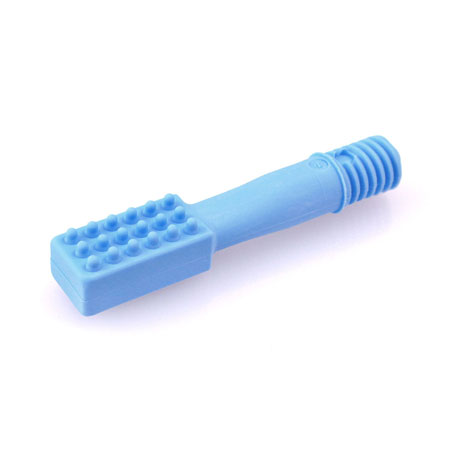
I also love the Probe which is your classic Z-Vibe Tip. I will use this one to stimulate the sides of the tongue. We need the sides of our tongue to lift to make the "s" sound. Our kids who are lateral s lispers, the sides of their tongue aren't going up. So sometimes stimulating the sides of the tongue with the Probe, [the Z-Vibe] turned on with vibration - is enough to help them realize, "Oh, that part of my tongue has to work!".
Some of my other favorites - I talked about the Bite Tubes, but I have my chewies [the Grabber]. I use these interchangeably with the Bite Tubes; it just depends on the kid.
.
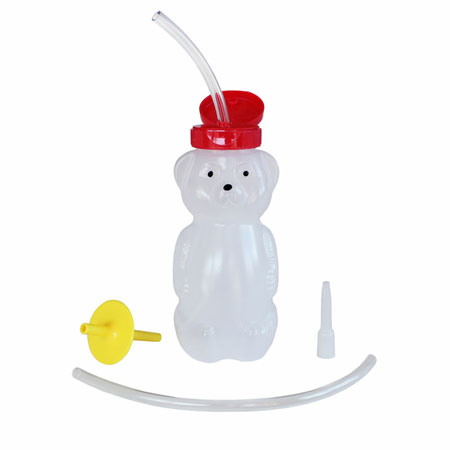
.
My last one I’ll leave you with - would be the honey bear cup [aka ARK's Bear Bottle]. I use this every single day. In an evaluation, I’ll leave the straw long to see and judge are we pulling water independently or not. And if they are, but taking a huge portion of the straw, I will add in a Lip Blok.
This is my favorite one [the Turquoise Lip Blok]. I joke with my kids, "Prepare yourself, it’s teeny tiny - this is the hardest one!" and then they love when they’re able to use it. We have to have a certain kid that can enjoy that kind of humor!
What the Lip Blok does, is that it keeps kids from being able to put the whole straw in their mouth and stabilize with anything other than their lips. So they really have to [wrap lips around the Lip Blok] have good lip activation to get this.
So I use this [the Lip Blok] in therapy and pop it into my straw - and again, I like to keep it long so I can see where the water is coming from.
As they go home and take a honey bear cup home with them, I’ll instruct parents to make the straw really, really short. I love the option of you can have the tool [the Lip Blok], if you want the tool - but also here’s a modification as to making that [straw] really short. And then they have to get that same lip rounding and lip closure.
My other favorite part of the honey bear is that if you take the select-flow valve out and you squeeze it [the Bear Bottle], I can control when the water comes out.
I have kids working on all the steps to prep for straw cups but they're not ready to pull water independently. [With the Bear Bottle] I can squeeze and control the water and help it go in without needing to do a funky straw trick where I put a straw in water and cover it with my finger then release it. I like not having to touch a kid's straw.
Those are my quick and dirty tips and tools that I like!
.
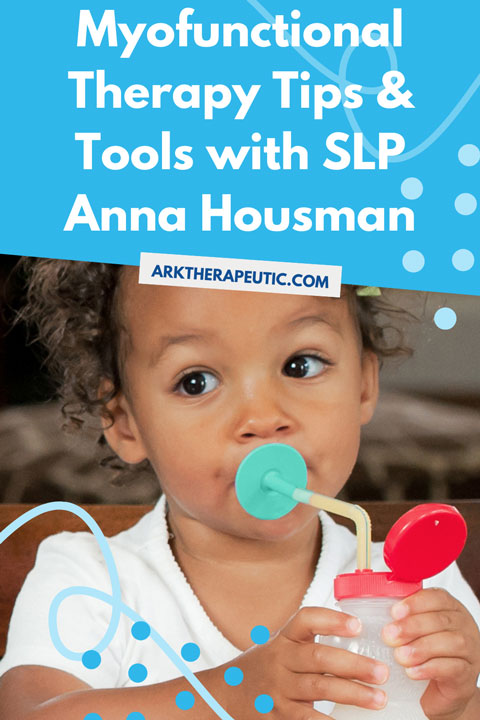
.
QUESTION TIME [30:00]:
Anna: Looking at our time, I want to make sure that we have time to answer questions and I saw in the chat an SLP interested in getting training. I recommend looking at the IAOM, the International Association of Orofacial Myology - that's where I’m getting my training through with my certification process. Other continuing education that’s been super helpful is The Breathe Institute with Chelsea Pinto and Dr. Zaghi and Debra Beckman's course.
Answering a question from Mariya in the chat: “ What kind of straw can you use with the valve?" The honey bear cup actually comes with this soft tubing straw, and it comes with the one-way valve that pops in for it.
Replying to a comment from Nicole in the chat: “Have found the one way valve is very challenging to use as pressure seems to change within the honey bear cup. love your idea to use without and have done that too. thank you.”] Nicole was saying that she found the one-way valve is very challenging to use. And I have to admit I almost never use it - but I do say to my parents who buy it, if your child is ready for it and they can do it - you have the option of a therapist approved cup, that’s not a sippy cup that won’t spill if you keep the valve in. So I usually only have that caveat for parents who are looking for a cup at home and trying to find a happy medium between they want to use a sippy cup, but I don’t want them to use a sippy cup.
Answering a question from Elaina in the chat: “ Do you use these tools with in person therapy or any virtual therapy?” I do both - usually with my virtual therapy, we work with what kids have at home. Although I’ve started, since I’ve been working and loving ARK so much - we’ve started putting together kits that our families can purchase and take away with them. Should they need to do virtual therapy, then they have the tools at home and we can work together.
And then Hannah, I want to check in with you - I can keep going on this chat!
Hannah: Thank you that was wonderful! But yes, there were a few questions that I wanted to get in before we ran out of time. And thank you for answering some of those that came through the chat! So we have the question: "At what age can a child start myofunctional therapy?"
Anna: That’s a great one! So we usually say that you need to be a very mature four year old - five is kind of the sweet spot for being able to sit and understand that I’m asking you to do these specific movements. That being said, between two and four - you can do therapy that is informed by orofacial myofunctional therapy, but is primarily feeding based. So it’s taking the same kind of concepts but working with food, rather than just these exercises.
Hannah: Okay, let’s see this one is from Vandana: "How best can we test for a tongue tie? So if a kiddo has severe Apraxia, and very restricted tongue movements - how best can you test for a tongue tie?"
Anna: Oh, that’s a hard one. There is a thought out there in the world, I heard it from Linda D’Onofrio, who is a speech therapist and highly valued in the OMD world - who says that she will not diagnose any child with any neurological disorders such as apraxia, until OMD has fully been ruled out. But those kids who have suspected apraxia, and need to do tongue tie - it can be a real challenge. There’s unfortunately no one specific way - it’s looking at the whole child’s function - watching them eat and drink. If you’re able to get under the tongue to do an assessment, there are a couple out there. But if you’re looking at it and haven’t taken coursework in TOTs, you aren’t really able to diagnose a tongue tie - and I would urge you not to. I would say instead, "I suspect it and see X, Y, Z that is pointing that way - they have a feeding disorder, and limited tongue movement." But then it’s a question of functional impact and the ability to complete therapy. It all gets considered in whether or not we then: release it, do we do therapy first, and how do we balance that out. So it’s a much more complicated question that I can answer!
Hannah: Yeah, thank you! So let’s see - "What is the treatment modality to look for in myofunctional therapy? How best can someone find a good local provider or is there a directory of providers to look for?"
Anna: Usually Google is your best friend in searching “orofacial myofunctional therapists near me”. People who are trained in it usually have it marketed on their website as such. There are also directories in IAOM and there’s the Academy of Orofacial Myofunctional Therapy (AOMT) - they both have directories listed. Oftentimes too, like The Breathe Institute, will have people listed as breathe ambassadors and those people are often trained and well versed in OMDs. But Google is probably your best bet!
Hannah: Another question: "Do you need a doctor's order before seeing a myofunctional therapist?"
Anna: I do not - most of the time. At least in North Carolina here, in the way we do things - I do not need a doctor’s referral if you’re a private paid client. Here in our clinic, we treat kids who are cash pay, some children who have your major medical and their families will submit and we help them file but usually not covered under us. There’s also clients who want to come in, that’s great. My kiddos who have Medicaid or one of the managed care plans, those do require a referral or script. It’s not usually very difficult to get and most of the time it’s fairly easy to at least get an evaluation in. On occasion we’ve had some pushback from those insurance providers about whether or not they’ll approve therapy, but we’ve got pretty good at arguing our case.
Hannah: We’ll try to get through one more. There’s been wonderful questions that came through! Let’s see - "Is it ever too late to start myofunctional therapy?"
Anna: No, it’s never too late! As somebody that had a tongue tie released and did myofunctional therapy at 33 - it’s never too late! I worked with recently, I don’t normally see adults but it was a friend’s mom - she started at 65, and it was really encouraging. She said for the last 20 years she had major TMJ pain and all those other things had been dismissed by everybody. We, in conjunction with PT - she and I were able to get to a point where when we checked her pain scale one day, she said “I can’t rate it for you because it’s the first time in 20 years I haven’t been in pain!”. So it’s never too late!
Hannah: That’s awesome! Thank you so much for your expertise and everything. Is there anything else that you wanted to add before we go?
Anna: No, I’m afraid if you got me started again that I would miss my client coming in at one o'clock so I will hold it there. But thank you so much for having me and I was so happy to give all this information - I wish I had the time to answer everybody's question.
Hannah: It’s been an honor! Thank you everyone that attended and thank you Anna - good luck with everything. We hope that everyone learned something new and we’ll see you next time!
.
Anna Housman, MS, CCC-SLP is a speech-language pathologist and orofacial myologist working in Durham, NC. She has been working in a private out-patient pediatric clinic for the last 7 years and prior to that worked in the public school system for a year and a half. The bulk of Anna's career has been spent focused on working in conjunction with occupational therapists to understand the sensory systems and how to integrate them into speech therapy to improve outcomes.
Starting in 2020 she began a deep dive into orofacial myology, starting the certification process with the IAOM. Since then her caseload has shifted to almost exclusively cover orofacial myofunctional disorders in infants up to adulthood.
Follow Anna on Instagram @emergepediatrictherapy or visit her website at www.emergepediatrictherapy.com.
.
